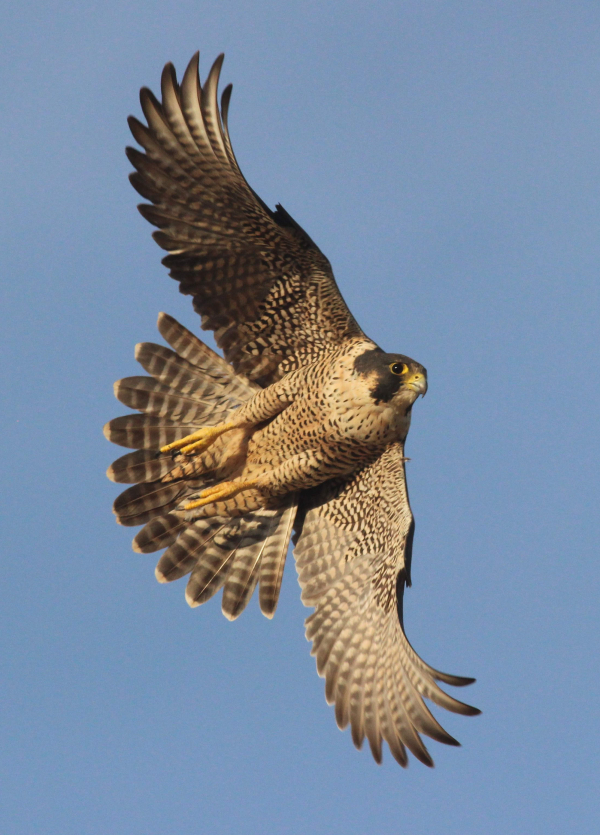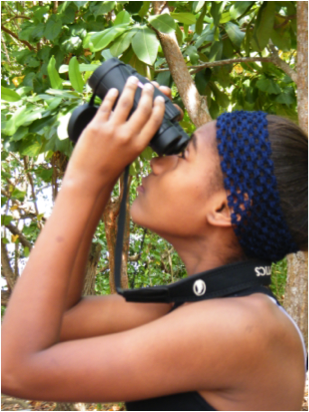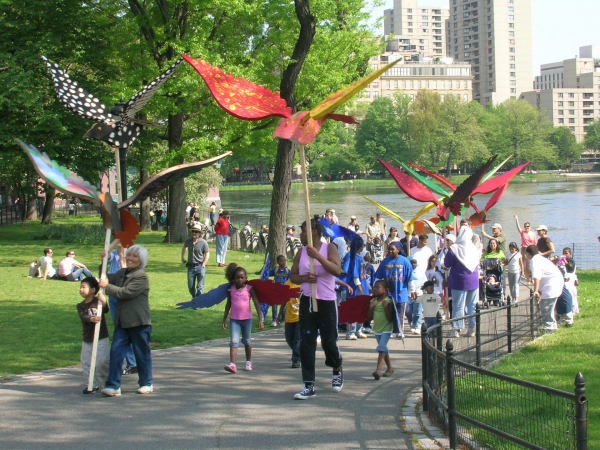
At the top of the urban bird scale is the fastest bird in the world, the Peregrine Falcon.

An initial interest in birds can expand in many directions for inner city youth. Green spaces, beginning yard to yard and block to block, are important for everyone.

“Celebrate Urban Birds” provides inspiration and information, as well as mini-grants for a variety of urban birding events and projects.
|
Big Cities attract their own communities of birds, and we backyard birders can do much to improve our urban neighborhoods to provide habitat for a greater variety of birds and for the benefit of people in our communities. While some people might think that urban birds may be limited to introduced species such as pigeons, collared doves, starlings, and House Sparrows, these birds may be present, but there are many other birds that do – or could – benefit from the efforts of backyard birders providing water, foods, and green space.
First, let’s take a closer look at some of the most iconic urban birds – the city pigeons we are all familiar with. On the positive side, “Rock Pigeons” are impressive in flight and add life and color to our urban settings. We all enjoy seeing a flock of Rock Pigeons take flight and appreciate the variety of colors and patterns individuals possess, especially when we see them up close. Honestly, even good field biologists can for a moment mistake a pigeon in flight for a rarer city dweller – a Peregrine Falcon. And this remarkable bird of prey is also a part of the urban avifauna of many large cities – nesting near the top of tall buildings and often preying on their somewhat look-alike Rock Pigeons.
Another exciting species in flight that inhabits our inner cities are Chimney Swifts, aerial dynamos that are most obvious during summer in late afternoon and evening when flying insects are most active overhead. Certainly, there are a wealth of species we find in our grand cityscapes, but it’s worth looking beyond what we see now, and imagining what we can do to improve our urban settings to expand the variety of interesting birds that would be attracted to and benefit from more bird-friendly surroundings.
Even individual bushes or a given tree can be a good starting point, and in neighborhood parks and other city property a number of native trees can be the start of an urban mini-forest – each tree and bush providing an element of habitat that can make a considerable difference to the overall potential. It all starts with one tree or bush, a new green space, and building on that – person by person, year after year – and the birds will respond, and prosper, through the actions of a few, or many of us.
Big City Backyard Birding
While we won’t attract Chimney Swifts or Peregrine Falcons to our urban feeding stations, urban birding includes all aspects of backyard birding, including offering fresh water, a variety of bird foods at our feeders, maybe a birdhouse, and some level of landscaping. Any landscaping may be limited by space, especially if you live in an apartment or a home with limited open space, but a collection of potted plants can benefit and attract certain birds; for example, a potted trumpet vine, or a stand of potted sunflowers.
Ultimately, never underestimate the importance of providing water for birds, or the attraction of birds to a bird bath or a simple elevated ceramic bowl of shallow water. If all you do is provide fresh water daily, you are doing a great service to birds, and you will attract new birds, especially during migration periods. Water is also a starting point for adding more attractions – in your yard, at a community park, and at city properties or green spaces.
Green Spaces for Birds & People
Birds that inhabit urban areas tend to be more limited in variety and numbers, but this calculation can emphasize a need for more urban green spaces, and a better utilization of the green spaces already available. On a grand scale, in the midst of New York City, America’s largest city, the value of Central Park to birds and birders can best be appreciated when you see the impressive lists of migrating songbirds and flycatchers that stopover in this mix of urban woodland and open grass during spring and fall migrations, not to mention the park’s importance to nesting and wintering birds. Obviously, people benefit as much or more than birds from parks and other green spaces, but landscaping definitely has mutual benefits. Any park of any size provides valuable urban habitat featuring plants, bushes, and trees – whatever the size and the level of landscaping.
Some urban neighborhoods utilize vacant lots as garden spaces; perhaps adding some plants to benefit birds might be appropriate in some of the sites, and adding a bird bath at each end of the property is definitely a nice touch – for birds, and aesthetically for people. Such an effort can be the catalyst to starting community birding projects. With some insights into the kinds of landscaping that benefits birds in green spaces, neighborhood groups and city parks departments can be instrumental in providing islands of habitat for birds and birders – not at the compromise of other activities, but as an added benefit to them.
In many ways, we birders can extend our reach beyond our yards to our neighborhoods and communities for the mutual benefit of birds and people. Consider how your neighborhood and the children and adults living there would benefit from a new or improved green space; and imagine how local government and business leaders might be helpful in providing that space that can be transformed into a location of pride and solace for local people, and an oasis for birds – migrating, resident, and wintering birds.
Celebrate Urban Birds
“Celebrate Urban Birds,” aka CUB, is a great source of information and ideas for urban birders. The CUB website provides insights into a variety of urban birding projects that vary from identifying and counting birds in your area to organizing community events, and even applying for mini-grants to plan and promote urban birding activities, including improving area green spaces for birds and community members.
If you are ready to take the next step, or wish to contact someone who would be willing to lead the charge in your neighborhood, there are mini-grant awards available from the Cornell Lab of Ornithology ranging from $2,500 to $250 that may be helpful in raising awareness in the form of community events and projects to benefit birds and local culture. Mini-grants are awarded to organizations in the United States and Canada, as well as communities in Latin America and the Caribbean. The mini-grant application is simple and easy to complete, and all applicants can receive free training, materials, and resources to bring their ideas to life in their neighborhood; see Mini-grants | Celebrate Urban Birds
CUB’s Latin American angle also provides birders living in Puerto Rico, Mexico, and other Spanish-speaking areas with a variety of ways to get more involved. Even if you’re not Spanish-speaking, it’s interesting to take a look at the Spanish webpages and the accompanying photos to see how far our interest in community birding goes as an expanded version of backyard birding.
Birding, including backyard birding, is another way for everyone to take greater pride in our homes, our yards, our neighborhoods, and our cities – in a number of enjoyable and productive ways. For more information about urban birds and urban birding opportunities, explore the CUB website at https://celebrateurbanbirds.org/
Share your backyard birding experiences and photos at editorstbw2@gmail.com